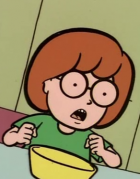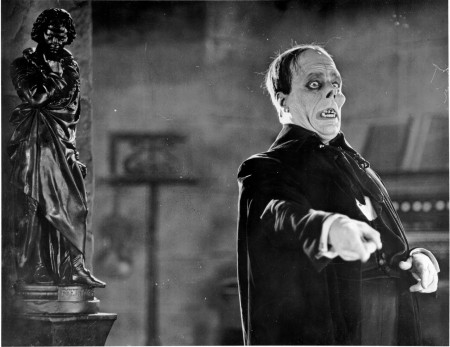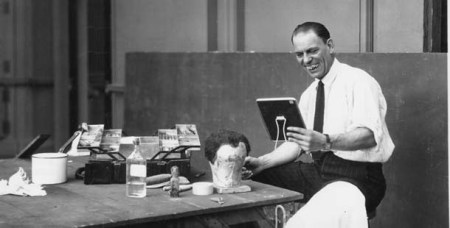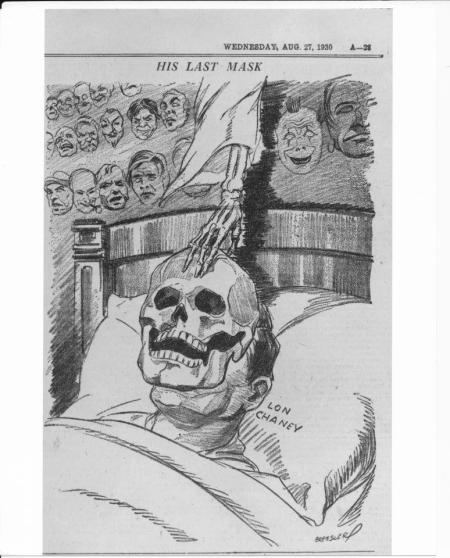Consider some of the most striking portraits that appear in horror films of the last century. The plasticky exterior of Jeff Goldblum’s face as his skin peels off scene-by-scene in David Cronenberg’s The Fly (1977). The blotchy, disgusting appearance of Linda Blair as she rotates her head a full 360 degrees in The Exorcist (1973). A unifying feature of modern cinematic horror is its preoccupation with defining antagonists by virtue of their perceivable “otherness” in relation to the societal norm. This practice owes a significant debt to the incredible work of one man: a pioneer in the use of dramatic make-up and a brilliant character actor.
Lon Chaney was one of the most popular and respected people of early cinema. Although performing in films across a number of genres, the movies of his which have survived (many of the 157 films have been lost) are those within a primal version of the horror format. Chaney painstakingly transformed himself for each screen role and was consequently labelled “the man of a thousand faces” by his contemporaries, helping lay the foundations for horror’s visceral visuals and its do-it-yourself mentality.
Born in 1883, Leonidas Chaney was immersed in acting from an early age – just not in any conventional sense. As a result of his deaf-mute parents Chaney’s childhood revolved around visual communication. Although we can only speculate about its impact, his ability to convey emotions visibly rather than audibly must have far exceeded his peers. Going from prop-boy to performer, his teenage years were spent working his way into acting roles and comedy troupes.
Chaney entered the motion picture business off the back of a failed marriage, taking low-paid jobs as extras in Universal’s early output. His passion for acting quickly propelled him into character-roles such as the contortionist The Frog in The Miracle Man (1919). Soon he was on Hollywood’s radar and was quickly becoming a household name. However, unlike other stars of the day like Chaplin and Keaton, Chaney did not create a trademark or unified persona. His legacy can be seen in opposition to this. He defined the cinematic experience of horror by embarking on scrupulous missions to morph himself into each and every role.
Chaney’s chameleon-like acting came in many shapes and sizes. He played phantoms, hunchbacks and vampires, gangsters, pirates and melancholy clowns. In The Penalty (1920) he found a way to clamp his lower legs behind him, becoming the hard-man amputee Blizzard. This gritty physicality followed Chaney throughout his career. He was a do-it-yourself make-up artist obsessed with bodily experimentation, willing to do whatever the role demanded in order to make it a success. By 1929 he was such an authority on make-up that he was asked to write its entry for the year’s edition of the Encyclopaedia Britannica.
His most iconic role came in the 1925 adaptation of Gaston Leroux’s novel The Phantom of the Opera. As the lonely Phantom, Chaney instilled fear into the decade’s cinema-goers and cemented his status as the first star of horror. The film’s lasting success is the visual suspense it generates around his central performance. For the first hour of the film the Phantom is merely alluded to: a shadow on the wall or a lone hand dropping a letter on the floor. A grotesque cellar-dweller catalogues his features to ballet dancers: “His nose – there is no nose!” Sticking closely to Leroux’s description of the Phantom as a “walking skeleton”, Chaney pinned his nose tight and high, sinking his eyes with heavy black make-up and installing misshapen false teeth.
When The Phantom finally appears, he is hidden behind a fitted white veil. Eventually his hostage Christine lifts the mask. The camera focuses head-on at his grimace; his maddening smile widens. “Feast your eyes – glut your soul on my accursed ugliness!” he says, terror and sadness abounding.
Chaney’s lasting impact on the horror world was felt during his lifetime as well as soon after his death. At the end of the 1920s he told Boris Karloff: “The trick in this business is to do something totally different from the rest so they’ll take notice of you.” Whilst not opening Hollywood’s doors to the young actor, the words did have a great result. In James Whale’s Frankenstein (1931), Karloff’s towering presence is reminiscent of Chaney’s transformative ability: the film’s final scene echoes that of Chaney’s dénouement in The Phantom of the Opera, with angry locals chasing the lone figure, pitchforks in hand.
Since his untimely death at the age of 47 there has been speculation about Chaney’s possible lead role in Dracula (1931). Whether it would or could have ever materialised (Chaney was then contracted to MGM and not Universal) his fatal throat cancer freed up Bela Lugosi to take the helm, and the rest is history. With Karloff and Lugosi as new figureheads the evolution of modern horror started to take shape, but it was Chaney who had established these towering monster-roles that would come to define the genre: Freddy, Jason, “Skinless” Frank, and Sadako from Ringu (1998).
More recently Chaney has also had a big influence on the ‘Godfather of Gore’ Tom Savini. Through slasher movies like Friday the 13th (1980) and the first wave of George A. Romero zombie-horrors, Savini signalled in a new era of on-screen bodily experimentation. Arms ripped off, exploding stomachs; blood, gore, death and destruction that all stem from his admiration of Chaney and the brutality of the Vietnam War.
And now, a whole 100 years after his first screen role (The Honour of the Family), his legacy is still being felt. In 2006 the actor Doug Jones was called the “Lon Chaney of today” by the Los Angeles Times. His scintillating performance in Guillermo del Toro’s Pan’s Labyrinth (2006) saw him completely transformed. Performing as both the Faun and the spindly Pale Man (echoing Chaney’s own double-roles in Treasure Island and Outside the Law (1920)), as well as his roles in the Hellboy series, Jones has produced some of the most memorable horror movie moments of this century. The Pale Man’s spindly naked exterior is truly haunting as he places eyeballs into the palms of his hands and holds them up to his face.
The legacy of Lon Chaney is contained within those tantalising, terrifying performances of horror’s most unforgettable characters: the monsters, villains and psycho killers. His on-screen emotional sensitivity worked brilliantly within the silent era. He was undoubtedly a magnificent actor, a screen-presence that makes you forget you are even watching a silent movie. It is testament to his greatness that the evolution of cinematic horror has picked up where he left off – learning from his legendary screen-presence while adding the dashes of colour, sound and technology that characterises modern film.
First published in New Empress film magazine (Issue 7, 2012): see http://www.freewebstore.org/New-Empress-Magazine-Webshop/New_Empress_Magazine_Issue_7/p679899_8011168.aspx



